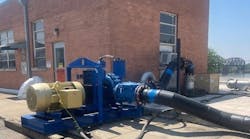Background
In the spring of 2010, AdEdge , working in conjunction with Ashley Engineering and WaterWorks Engineers, was selected through a competitive bidding process to design, manufacture and start up a water treatment system for the city of Aurora, Ore., to treat elevated levels of arsenic, iron and manganese. The Aurora water system consists of three wells feeding into a centralized distribution system with a maximum combined capacity of 500 gal per minute (gpm). Water exiting the treatment system feeds a 300,000-gal storage tank and is re-pressurized and distributed to end-users. The raw water analysis revealed an average arsenic level of 12 parts per billion (ppb), iron concentrations of 0.01 to 0.9 mg/L and manganese concentrations of 0.006 to 0.189 mg/L. In addition to the treatment system, the project included a new building, backwash recycle storage tank, piping and other infrastructure. Following the preparation of the design submittals, AdEdge worked closely with the selected general contractor, Cascade Water, and the engineer to supply the specified treatment unit and start up the system.
The Treatment System
The AdEdge treatment system features a completely skid-mounted APU26 oxidation/filtration package unit sized for a maximum design flow rate of 500 gpm. The model APU26-7260CS-S-3-AVH utilizes AdEdge AD26GS+ media in a three-vessel carbon steel configuration in parallel. The media is well suited for co-contaminant removal applications. The system is equipped with automated control valves and piping harness, a central control panel with programmable logic controller and a color user interface screen. System features also include various instrumentation, such as differential pressure transducers, local gauges, flow sensors and totalizers and a central hydraulic panel with sample ports for a complete functioning packaged unit. A chemical feed system provides a continuous feed of sodium hypochlorite to aid in the oxidization of iron, manganese and arsenic (III) to arsenic (V) for optimal contaminant removal. In addition, a backwash recycle system conserves water by storing and treating contaminated backwash water.
System Performance
The complete system was packaged and delivered for site installation in September 2010 and was placed into full operation in November 2010, processing an average 216,000 gal per day. Since operations began, the system has consistently removed the arsenic to well below the U.S. Environmental Protection Agency maximum contaminant level of 10 ppb. Iron and manganese in the treated water also has been consistently recorded to below detection levels.


